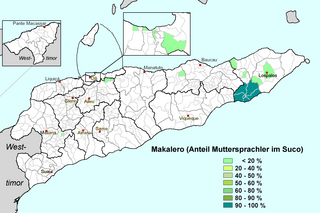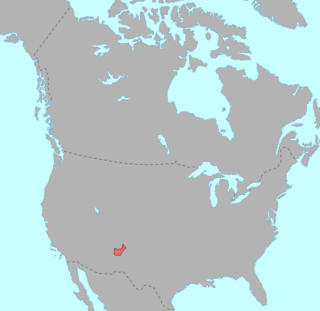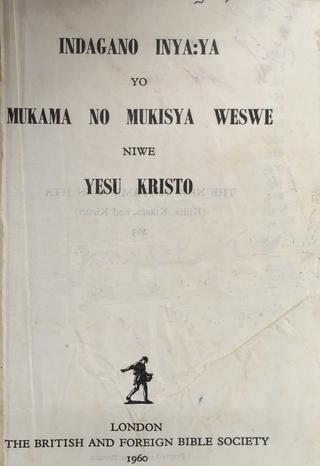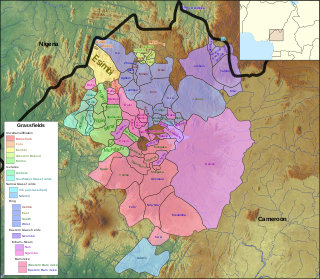Related Research Articles

Sandawe is a language spoken by about 60,000 Sandawe people in the Dodoma Region of Tanzania. Sandawe's use of click consonants, a rare feature shared with only two other languages of East Africa – Hadza and Dahalo, had been the basis of its classification as a member of the defunct Khoisan family of Southern Africa since Albert Drexel in the 1920s. Recent investigations however suggest that Sandawe may be related to the Khoe family regardless of the validity of Khoisan as a whole. A discussion of Sandawe's linguistic classification can be found in Sands (1998).

The Tlingit language is spoken by the Tlingit people of Southeast Alaska and Western Canada and is a branch of the Na-Dene language family. Extensive effort is being put into revitalization programs in Southeast Alaska to revive and preserve the Tlingit language and culture.

Makalero or Maklere is a Papuan language spoken in the Lautém district of East Timor. It was previously considered to be a dialect of Makasae, but is nowadays seen as a separate language, both by its speakers and linguists.

Keres, also Keresan, is a Native American language, spoken by the Keres Pueblo people in New Mexico. Depending on the analysis, Keres is considered a small language family or a language isolate with several dialects. The varieties of each of the seven Keres pueblos are mutually intelligible with its closest neighbors. There are significant differences between the Western and Eastern groups, which are sometimes counted as separate languages.
Goemai is an Afro-Asiatic language spoken in the Great Muri Plains region of Plateau State in central Nigeria, between the Jos Plateau and Benue River. Goemai is also the name of the ethnic group of speakers of the Goemai language. The name 'Ankwe' has been used to refer to the people, especially in older literature and to outsiders. As of 2008, it was estimated there were around 200,000 ethnic Goemai, but it is unknown how many of these are native speakers of the language.

Mongsen Ao is a member of the Ao languages, a branch of the Sino-Tibetan languages, predominantly spoken in central Mokokchung district of Nagaland, northeast India. Its speakers see the language as one of two varieties of a greater "Ao language," along with the prestige variety Chungli Ao.
The Sikkimese language, also called Sikkimese, Bhutia, or Drenjongké, Dranjoke, Denjongka, Denzongpeke and Denzongke, belongs to the Tibeto-Burman languages. It is spoken by the Bhutia in Sikkim, India and in parts of Province No. 1, Nepal. The Sikkimese people refer to their own language as Drendzongké and their homeland as Drendzong. Up until 1975 Sikkimese was not a written language. After gaining Indian Statehood the language was introduced as a school subject in Sikkim and the written language was developed.
Kanakanavu is a Southern Tsouic language spoken by the Kanakanavu people, an indigenous people of Taiwan. It is a Formosan language of the Austronesian family.

Hajong is an Indo-Aryan language with a possible Tibeto-Burman language substratum. It is spoken by approximately 80,000 ethnic Hajongs across the northeast of the Indian subcontinent, specifically in the states of Assam, Meghalaya, Arunachal Pradesh, and West Bengal in present-day India, and the divisions of Mymensingh and Sylhet in present-day Bangladesh. It is written in Bengali-Assamese script and Latin script. It has many Sanskrit loanwords. The Hajongs originally spoke a Tibeto-Burman language, but it later mixed with Assamese and Bengali.
Taos is a Tanoan language spoken by several hundred people in New Mexico, in the United States. The main description of its phonology was contributed by George L. Trager in a (pre-generative) structuralist framework. Earlier considerations of the phonetics-phonology were by John P. Harrington and Jaime de Angulo. Trager's first account was in Trager (1946) based on fieldwork 1935-1937, which was then substantially revised in Trager (1948). The description below takes Trager (1946) as the main point of departure and notes where this differs from the analysis of Trager (1948). Harrington's description is more similar to Trager (1946). Certain comments from a generative perspective are noted in a comparative work Hale (1967).

Moloko (Məlokwo) is an Afro-Asiatic language spoken in northern Cameroon.
Sheko is an Omotic language of the Afro-Asiatic language family spoken in the area between Tepi and Mizan Teferi in western Ethiopia, in the Sheko district in the Bench Maji Zone. The 2007 census lists 38,911 speakers; the 1998 census listed 23,785 speakers, with 13,611 identified as monolinguals.
This article is about the sound system of the Navajo language. The phonology of Navajo is intimately connected to its morphology. For example, the entire range of contrastive consonants is found only at the beginning of word stems. In stem-final position and in prefixes, the number of contrasts is drastically reduced. Similarly, vowel contrasts found outside of the stem are significantly neutralized. For details about the morphology of Navajo, see Navajo grammar.
Komo is a Nilo-Saharan language spoken by the Kwama (Komo) people of Ethiopia, Sudan and South Sudan. It is a member of the Koman languages. The language is also referred to as Madiin, Koma, South Koma, Central Koma, Gokwom and Hayahaya. Many individuals from Komo are multilingual because they are in close proximity to Mao, Kwama and Oromo speakers. Komo is closely related to Kwama, a language spoken by a group who live in the same region of Ethiopia and who also identify themselves as ethnically Komo. Some Komo and Kwama speakers recognize the distinction between the two languages and culture, whereas some people see it as one "ethnolinguistic" community. The 2007 Ethiopian census makes no mention of Kwama, and for this reason its estimate of 8,000 Komo speakers may be inaccurate. An older estimate from 1971 places the number of Komo speakers in Ethiopia at 1,500. The Komo language is greatly understudied; more information is being revealed as researchers are discovering more data about other languages within the Koman family.
Proto-Tibeto-Burman is the reconstructed ancestor of the Tibeto-Burman languages, that is, the Sino-Tibetan languages, except for Chinese. An initial reconstruction was produced by Paul K. Benedict and since refined by James Matisoff. Several other researchers argue that the Tibeto-Burman languages sans Chinese do not constitute a monophyletic group within Sino-Tibetan, and therefore that Proto-Tibeto-Burman was the same language as Proto-Sino-Tibetan.
The Abawiri language, is a Lakes Plain language of Papua, Indonesia. It is spoken in the village of Fuau, located along the Dijai River, a tributary to the Mamberamo River. Clouse tentatively included Abawiri and neighboring Taburta (Taworta) in an East Lakes Plain subgroup of the Lakes Plain family; due to the minimal data that was available on the languages at that time. With more data, the connection looks more secure.
Belanda Bor, or just Bor, is a Luo language of South Sudan. Most speakers also use Belanda Viri, which is a Ubangian language and not at all related.

Jita is a Bantu language of Tanzania, spoken on the southeastern shore of Lake Victoria/Nyanza and on the island of Ukerewe.

Babanki, or Kejom, is the traditional language of the Kejom people of the Western Highlands of Cameroon.
There are several differences in pronunciation between Standard Arabic and Tunisian Arabic. Nunation does not exist in Tunisian Arabic, and short vowels are frequently omitted, especially if they would occur as the final element of an open syllable, which was probably encouraged by the Berber substratum.
References
- ↑ Poula at Ethnologue (25th ed., 2022)

- ↑ Veikho, Sahiinii Lemaina (2019). "A Grammar of Poumai Naga". University of Bern, Switzerland: PhD Dissertation.
- 1 2 Veikho, Sahiinii Lemaina; Khyriem, Barika (2015). "Poula phonetics and phonology: An initial overview". North East Indian Linguistics. 7: 47–62.
- ↑ Veikho, Sahiinii Lemaina; Sarmah, Priyankoo (2018). "Vowels and tones in Poula". Linguistics of the Tibeto-Burman Area. 41 (1): 22–45. doi:10.1075/ltba.16022.lem. S2CID 69460833.
- ↑ Veikho, Sahiinii Lemaina (2019). "A Grammar of Poumai Naga". University of Bern, Switzerland: PhD Dissertation.
- ↑ Veikho, Sahiinii Lemaina (2019). "A Grammar of Poumai Naga". University of Bern, Switzerland: PhD Dissertation.
